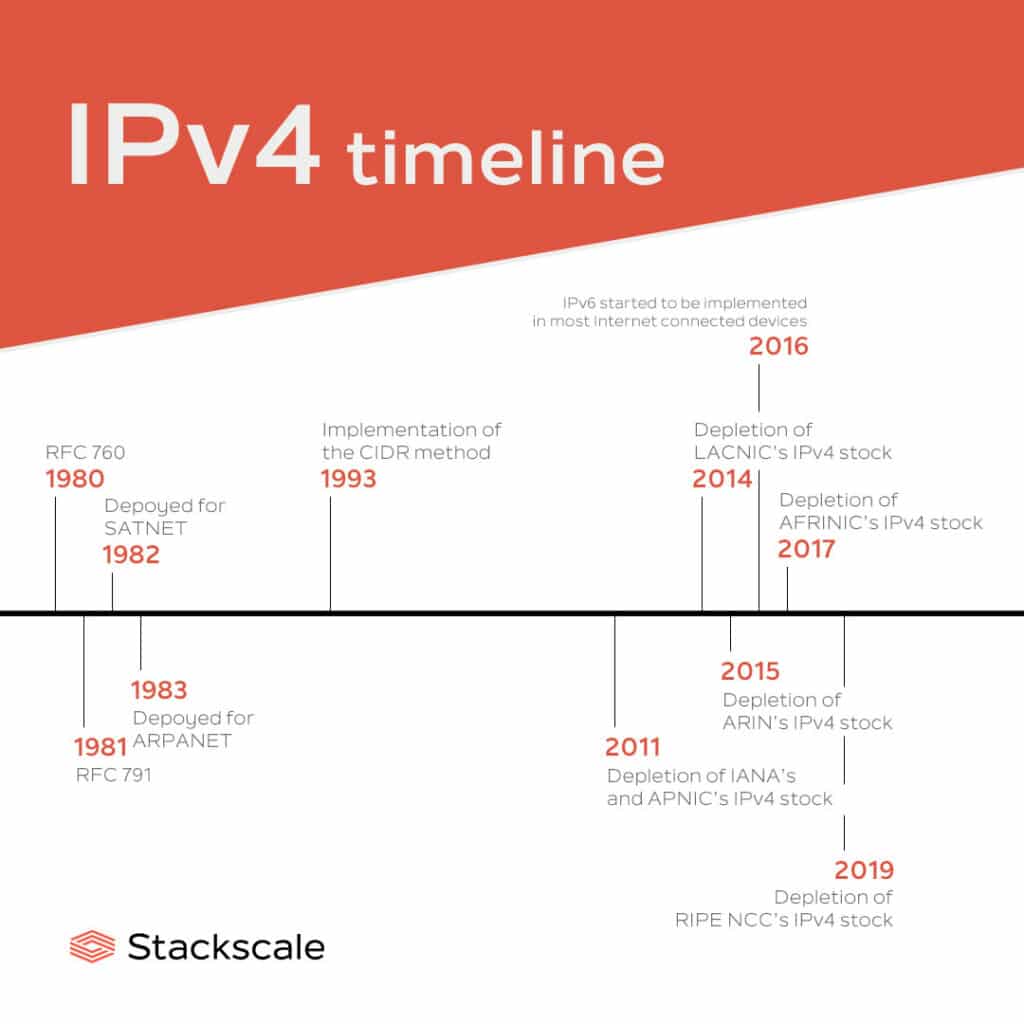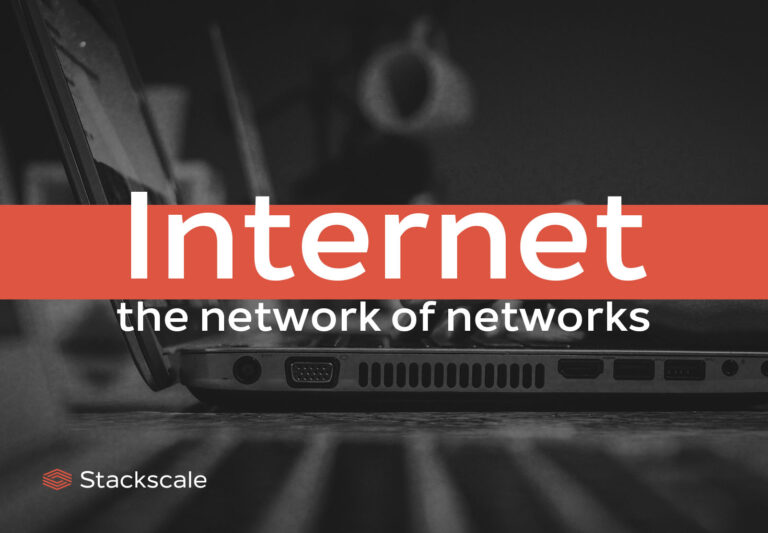The exhaustion of IPv4 addresses has been a concern for more than a decade. IPv4 addresses are 32-bit and provide 4,294,967,296 unique addresses. Such a number of IP addresses has become insufficient for the current number of worldwide devices connected to the Internet. However, IPv4 is still the Internet Protocol that routes most of the Internet traffic, as IPv6 adoption is taking place at a slow pace.
IPv4 address exhaustion
The Internet Protocol version 4 or IPv4 was defined in 1980 in RFC 760 and then described in RFC 791 in 1981. Later on, it was deployed for SATNET in 1982 and for ARPANET in 1983.
During the 1980s, the future depletion of IPv4 addresses was already apparent; since they were exhausting at a faster rate than anticipated. The rapidly growing number of Internet users and the increase in mobile devices accelerated the run-out. Therefore, new technologies had to be developed and adopted to slow it down. For instance:
- Classless Inter-Domain Routing (CIDR).
- Network Address Translation (NAT).
- Carrier-Grade NAT (CGNAT).
- IPv4 transfer market.
- Internet Protocol version 6 (IPv6), as a long-term solution.
IANA’s (Internet Assigned Numbers Authority) global stock of available IPv4 addresses was depleted in 2011. Regional Internet Registers (RIRs) ran out of IPv4 addresses as follows (except for addresses destined to IPv6 transition):
- The Asia Pacific Network Information Centre (APNIC): April 2011.
- The Latin America and Caribbean Network Information Centre (LACNIC): June 2014.
- The American Registry for Internet Numbers (ARIN): September 2015.
- The African Network Information Centre (AFRINIC): April 2017.
- The Réseaux IP Européens Network Coordination Center (RIPE NCC): November 2019.
As a result, it is no longer possible to opt for IPv4 addresses that have not previously been used by others.
Internet Protocol version 4 timeline

Solutions to IPv4 run-out
The version 6 of the protocol was developed as the long-term solution to this problem; as it would provide a significantly higher number of unique IP addresses. However, previously to IPv6, other technologies were implemented to slow down IPv4 run-out.
Classless Inter-Domain Routing (CIDR)
The Internet Engineering Task Force (IETF) implemented the CIDR method to slow down the fast depletion of IPv4 addresses in 1993. CIDR is the acronym for Classless Inter-Domain Routing. It was designed as a new network standard for allocating IP addresses and IP routing. It introduced the CIDR notation, a new, compact method for representing IP addresses.
In the CIDR notation, addresses are written with a suffix, introduced by a slash (/), that indicates the number of bits of the prefix. For instance, the suffix /16 means that the first 16 bits out of the 32 bits of an IPv4 address are defined by the network and the other 16 bits left are defined by the host.
From classful network architecture to CIDR
The classful IP addressing architecture was used from 1981 until 1993, when the CIDR was introduced. This method divided the IP address space for IPv4 into five classes (from A to E), based on the leading 4 bits of the address. Transitioning from classful network addressing to the CIDR method considerably delayed the depletion of IPv4 addresses.
Network Address Translation (NAT)
NAT or IP masquerading allows ISPs and companies to use special private IP addresses to connect computer networks to the Internet using a single, public IP address. This way, they can use an IPv4 for an entire private network instead of an IP address per network device. NAT has also been key for mitigating IPv4 address exhaustion.
Carrier-Grade NAT or CGNAT
CGNAT is a type of NAT used by ISPs to provide Internet access to customers. It allows multiple users to share a public IP address. CGNAT is also known as Large-Scale NAT (LSN).
IPv4 transfer market
Acquiring addresses via the IPv4 transfer market is another way for organizations to get additional IPv4 addresses in order to keep growing and adding new users. This transfer market accelerated as the global stock of IP addresses depleted.
Transfers can be either intra-RIR, within the same region, or inter-RIR, between different regions. RIRs stand in the middle of transfers as they are responsible for managing the registration records.
Internet Protocol Version 6 (IPv6)
As we explain in our article about IPv6 and its adoption, the transition to IPv6 is necessary for technological advancements. As well as the only long-term solution to the issues derived from IPv4 depletion.
Differences between IPv6 and IPv4
Although both IPv6 and IPv4 are used to identify machines connected to a network, there are many differences between both protocols. These are some of them:
| Internet Protocol version 6 | Internet Protocol version 4 | |
| IP address size | 128 bits | 32 bits |
| Addressing method | Alphanumeric and binary bits separated by a colon (:). | Numeric and binary bits separated by a dot (.). |
| Classes of IP addresses | A nearly unlimited number of IP addresses. Moreover , it includes support for ranges considered as “private”. | 5 different classes of IP addresses. |
| Configuration | Optional configuration depending on the functions needed. Besides, it supports autoconfiguration between IPv6 devices. | Each system must be configured in order to communicate with others. The network is also set up manually or using DHCP. |
| Interoperability | Interoperability and mobility capabilities are included in network devices. | Network topologies are rather restricted, with limited interoperability and mobility capabilities. |
Internet Protocol
The Internet Protocol (IP) is a communications protocol used to transfer data between IP addresses through a network. IP addresses are numerical addresses used to identify the different devices that are connected to the Internet. They allow delivering data packets from one host to another.
IANA and five regional Internet registers are responsible for managing and assigning IP addresses. Besides, special address blocks are reserved for private networks and multicast addresses.
To sum up, although diverse methods have been put in place to slow down and mitigate the exhaustion of IPv4 addresses, IPv6 is the long-term solution to it. That is why, from the beginning, Stackscale has been a leader in the adoption and implementation of IPv6 on its network. All Stackscale customers can deploy services on this new protocol, which should end up replacing the Internet Protocol version 4.




